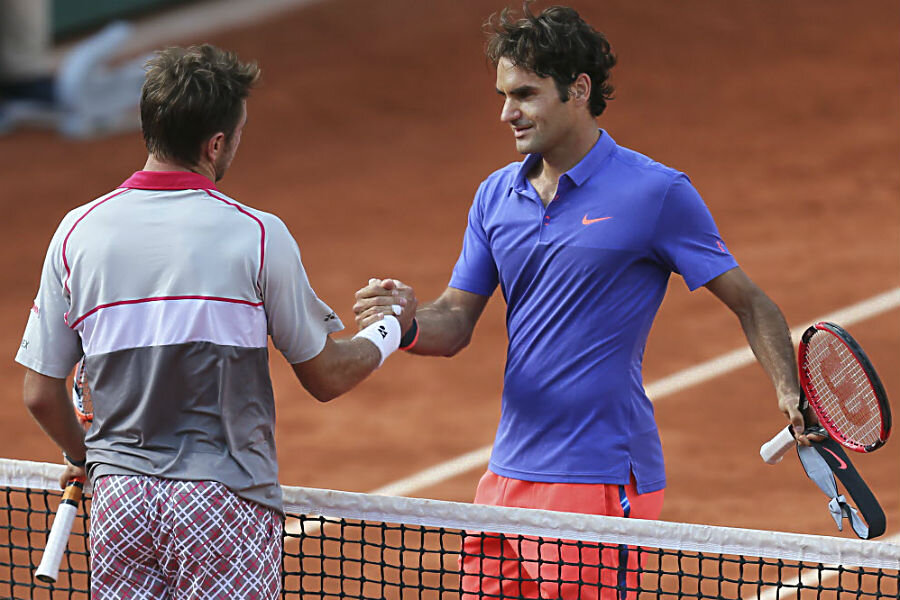Wawrinka dominates Federer in French Open quarterfinals. What happened?
Loading...
| Paris
Stumbling on his way to the net, Roger Federer dropped his racket and fell to his knees on the red clay. Hardly the sort of grace and precision the world has come to expect from the 17-time Grand Slam champion.
There were other unusual sights in Federer's 6-4, 6-3, 7-6 (4) loss in the French Open quarterfinals Tuesday against his pal and Swiss Davis Cup teammate Stan Wawrinka.
"I made 30-something errors today. He, maybe, made one," said Federer, exaggerating a bit.
Rarely injured and appearing in a 62nd consecutive major, Federer received treatment on his right hand from a trainer during a second-set tiebreaker. For years and years, a dominant and confident force in tennis, Federer slumped in his changeover chair, head bowed, after falling behind two sets to none.
So long superior to the younger Wawrinka, Federer was defeated for only the third time in their 19 head-to-head matches, and for the first time in five meetings at Grand Slam tournaments.
"I tried many things. One of them was trying to put (the ball) up high. Another one was trying to chip it shorter. Another one was trying to hit through the wind," Federer said. "Obviously I was not going to leave the French Open without having tried everything out there."
During the eight French Opens from 2005 to 2012, Federer reached at least the semifinals seven times, including winning the 2009 championship to complete a career Grand Slam. But this is now the third year in a row that he has exited Roland Garros in the quarterfinals or earlier.
Give Wawrinka credit. Powering the ball from the baseline in Court Suzanne Lenglen on a windy day, he produced groundstrokes that cut through gusts topping 30 mph (50 kph).
Over at Court Philippe Chatrier, during the quarterfinal between Jo-Wilfried Tsonga and Kei Nishikori, three people were injured when a piece of metal paneling was blown off a giant TV screen and fell on the stands below.
Late in the third set of Federer's loss, he missed a backhand that got caught in the wind and let out a guttural "Aaaaah!" He never managed to consistently find the range on his shots, and Wawrinka put together a 43-28 edge in winners.
Wawrinka also managed to break Federer's serve three times, while saving all four break points he faced. All of those chances for Federer came in the first set.
As well as Wawrinka played, he probably would have been just fine without the point conceded by Federer that made it 4-3 for the eventual winner after a disputed call in the tiebreaker.
"I played my best match in a Grand Slam tournament," the eighth-seeded Wawrinka said, quite a statement considering he won the championship at the 2014 Australian Open, "and my best match on clay."
This is his 11th appearance at Roland Garros, equaling the most in the professional era, which began in 1968, for a man getting to his first semifinal in Paris.
"We (knew) he can do this," Federer said. "It's just nice for him now, even talking for him, to string it together on a big occasion like this at the French, where I always thought he'd have his best chance to do well."
Wawrinka next faces No. 5 Nishikori or No. 14 Tsonga, whose match was interrupted for about 40 minutes after the piece of metal hit a barrier and a piece of equipment on its way down, slowing its fall before tumbling onto packed rows of spectators. French Open organizers said none of the injuries was serious.
The quarterfinals on the other half of the men's draw are Wednesday, with a real blockbuster looming: No. 1 Novak Djokovic against nine-time champion Rafael Nadal. No. 3 Andy Murray plays No. 7 David Ferrer in the other quarterfinal.
One women's semifinal was set Tuesday: No. 7 Ana Ivanovic of Serbia against No. 13 Lucie Safarova of Russia.
Safarova, who beat defending champion Maria Sharapova in the fourth round, beat Garbine Muguruza 7-6 (3), 6-3 to reach the second major semifinal of her career.
Ivanovic reached her first Grand Slam semifinal since winning the 2008 French Open, eliminating 20-year-old Elina Svitolina of Ukraine 6-3, 6-2.
"I don't know if I should feel very old," said Ivanovic, 27, "or very happy."
Copyright 2015 The Associated Press. All rights reserved. This material may not be published, broadcast, rewritten or redistributed.







